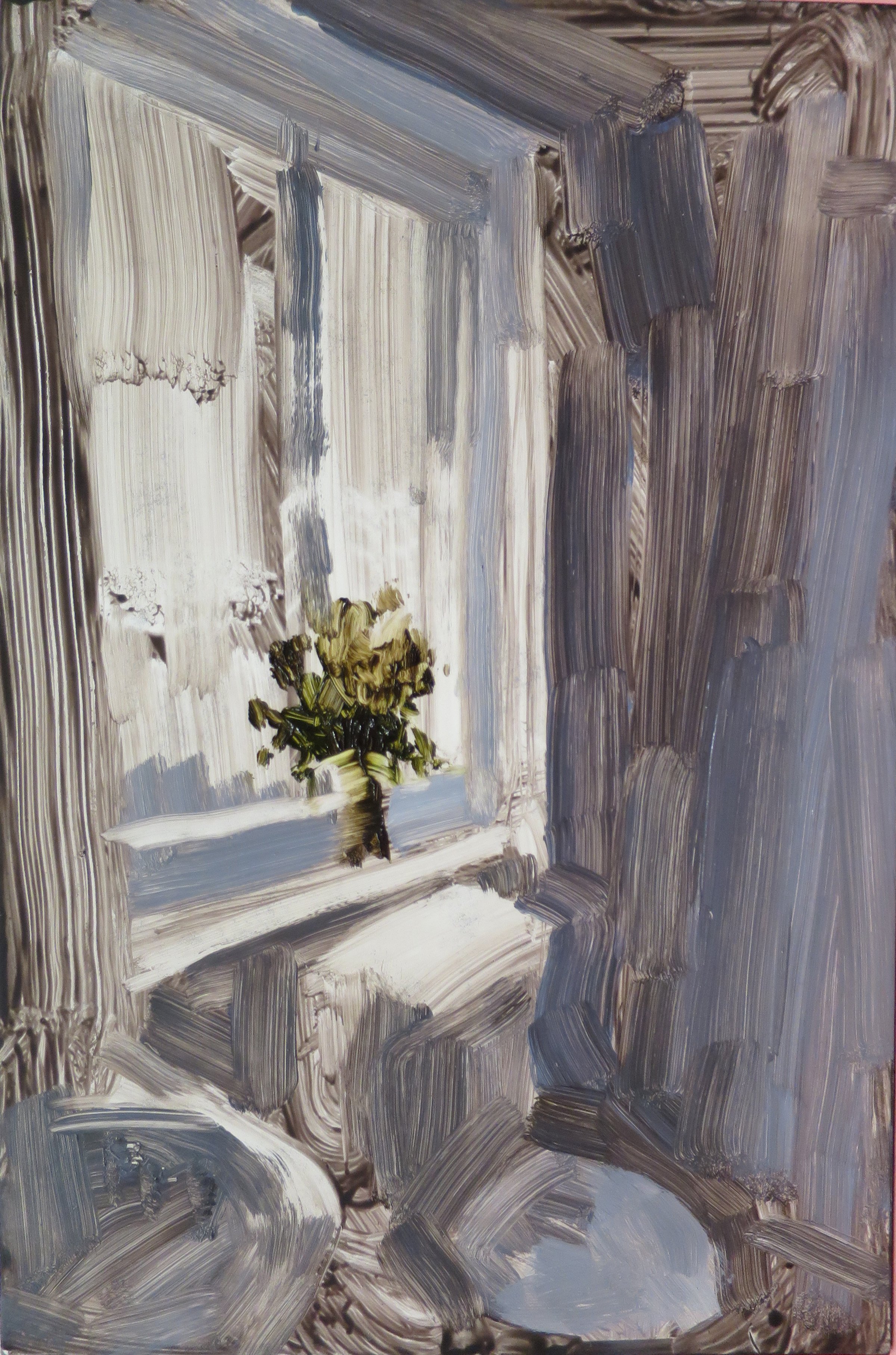It’s in the not knowing
Commissioned exhibition catalogue essay for Making Beds by Miranda Hine at MARS Gallery (Melbourne, Australia). The exhibition is on show from 9th May – 1st June, 2024.
Dennis Severs' House (bed), 2023, Oil on board, 22.8 x 15cm.
Having recently relocated from Brisbane, Australia, to London, UK, artist Miranda Hine quickly discovered the plethora of museums and galleries that scatter the city. Continuing her exploration into British narrative formats and their resonance within an Australian context, English historic house museums became the subject of Hine’s latest exhibition, Making Beds. Shifting from the captivating and sinister genre of popular British crime drama, which was the focus of her previous body of work Hot Trail, her latest collection of small-scale oil paintings breadcrumb the act of reconstructing and remembering as alluring and malleable. Hine notes that she was curious about these spaces as they are equal parts deeply intimate and absurdly public. And when reconciling her roles as both curator and artist, it became abundantly clear that they are the result of meticulous curation, and by proxy, are an act of constructed, sometimes even fictitious remembering.
What have these walls seen? One may carelessly ask of the interior of The Sherlock Holmes Museum at 221B Baker Street. Never mind that this space is entirely fabricated, given that figure only ever existed within the pages of books and on cinema screens. Would it tarnish your fantasy to know that Charles Dickens only occupied the Doughty Street house in which his museum is located for just two years? Or that ‘The Dictionary of the English Language’ located in the very room Dr Johnson wrote it was placed by the museum’s curator 155 years after his death, following its use as a hotel, a print shop and a storehouse? And then there's the Dennis Severs’ House – a methodically reconstructed 18th Century family dwelling. A historical tableau designed by Severs in the 1980’s—a wistful ode to a bygone era, an infatuated love letter to a time, a place, and people forever beyond his, as well as our, grasp
Hine muses that ‘perhaps it is not coincidental that so many of those being memorialised in these houses are themselves producers of stories and language.’ One then wonders about the intention of these notorious occupants. Could they fathom that their homes would one day be on display to whoever wears the price of a ticket inside? Did the edifice of their storytelling extend beyond literature and into the fabric of their own personal narratives?
With firsthand experience in understanding the layers of choice, construction, and intent involved in exhibition-making, Hine employs methods akin to the curation of these homes to evoke a sense of nostalgia and romanticism. Her renderings of space are soft and quick, and in their small scale and quixotic colorations, pull you close to their surface. Rather than labouring over the detail of individual objects, the collection of slippery strokes of paint prioritises fundamental forms and the touch and play of light. Each work is a tender, interior act. A dreamy mise en scène. There is a longing to linger and bask in the contentment of every space, as her painterly application creates a kind of familiarity by proxy. However, it's only when one recalls that each scene depicted is so distant from reality, that you realise the artist doesn't know these houses or their inhabitants any better than the viewer does — it is a constructed closeness.
This effect makes each artwork seem patient. Hine renders the velvet of Dennis Severs’ armchair so quietly, that it feels as if it might slide into the wallpaper, floor or curtains cornered in its nook. The pale-yellow interjection of a candle’s flame amongst the dark russet shadows of the Sherlock Holmes Museum gives the implication that set table before it awaits its imaginary guests. This tension points to the uncanny permanence of these historical homes. Enduring in their purpose as public exhibitions with occupants only observing and always in transit, they exist endlessly, destined to never truly be homes again.
With time, we cling tightly to what is deemed ‘important enough’ to be remembered, but tighter still to the mystique of the unknown, as if it may eventually unfurl and reveal itself. And as curious as we are to gain a glimmer of insight into what these past figures may have been like behind closed doors, it is the clandestine nature of their legacies that we feel most feverish about. Making Beds encourages us to dwell on the role of storytelling in shaping our understanding of history, which is so often distorted between the lines of fact and fiction, the known and unknown. We are drawn to these characters and their environments, seeking insight into their personalities and motivations, but ultimately, we can only speculate based on the curated narratives presented to us. After all, what common ground do we share with an eccentric genius detective, a Victorian literary luminary, or an 18th-century aristocratic family? History has neatly made their beds of legacy, and we, instinctively following suit, find ourselves lying in them.
Miranda Hine
Miranda Hine’s painting practice explores forms of personal documentation, cataloguing, ordering and ambiguous narrative construction that aligns with her museums research. With a background in sculpture, video and installation, her current practice centres on painting. Drawing inspiration from her curatorial practice, Hine investigates notions of categorisation in her dreamy paintings, exploring common themes through a lens of art history and museum theory, and questioning boundaries of objective truth and personal interpretation.
Along with being a 2022 recipient of the Brett Whiteley Travelling Art Scholarship Kangaroo Valley residency, Hine was a finalist in the 2023 Wynne Prize at the Art Gallery of New South Wales, Sydney, and was awarded highly commended in the 2023 STILL: National Still Life Award.







